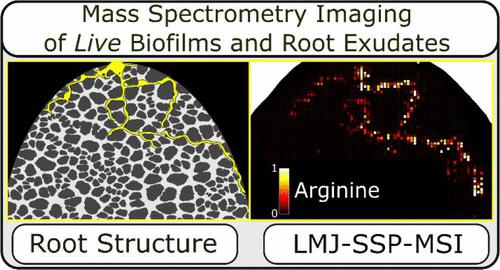当前位置:
X-MOL 学术
›
ACS Environ. Au
›
论文详情
Our official English website, www.x-mol.net, welcomes your
feedback! (Note: you will need to create a separate account there.)
In Situ Detection of Amino Acids from Bacterial Biofilms and Plant Root Exudates by Liquid Microjunction Surface-Sampling Probe Mass Spectrometry
ACS Environmental Au ( IF 6.7 ) Pub Date : 2022-07-29 , DOI: 10.1021/jasms.2c00081 Courtney L. Walton 1 , Muneeba Khalid 1 , Amber N. Bible 1 , Vilmos Kertesz 1 , Scott T. Retterer 2 , Jennifer Morrell-Falvey 1 , John F. Cahill 1
ACS Environmental Au ( IF 6.7 ) Pub Date : 2022-07-29 , DOI: 10.1021/jasms.2c00081 Courtney L. Walton 1 , Muneeba Khalid 1 , Amber N. Bible 1 , Vilmos Kertesz 1 , Scott T. Retterer 2 , Jennifer Morrell-Falvey 1 , John F. Cahill 1
Affiliation

|
The plant rhizosphere is a complex and dynamic chemical environment where the exchange of molecular signals between plants, microbes, and fungi drives the development of the entire biological system. Exogenous compounds in the rhizosphere are known to affect plant-microbe organization, interactions between organisms, and ultimately, growth and survivability. The function of exogenous compounds in the rhizosphere is still under much investigation, specifically with respect to their roles in plant growth and development, the assembly of the associated microbial community, and the spatiotemporal distribution of molecular components. A major challenge for spatiotemporal measurements is developing a nondisruptive and nondestructive technique capable of analyzing the exogenous compounds contained within the environment. A methodology using liquid microjunction-surface sampling probe-mass spectrometry (LMJ-SSP-MS) and microfluidic devices with attached microporous membranes was developed for in situ, spatiotemporal measurement of amino acids (AAs) from bacterial biofilms and plant roots. Exuded arginine was measured from a living Pantoea YR343 biofilm, which resulted in a chemical image indicative of biofilm growth within the device. Spot sampling along the roots of Populus trichocarpa with the LMJ-SSP-MS resulted in the detection of 15 AAs. Variation in AA concentrations across the root system was observed, indicating that exudation is not homogeneous and may be linked to local rhizosphere architecture and different biological processes along the root.
中文翻译:

液体微结表面采样探针质谱法原位检测细菌生物膜和植物根系分泌物中的氨基酸
植物根际是一个复杂而动态的化学环境,植物、微生物和真菌之间的分子信号交换驱动着整个生物系统的发展。众所周知,根际中的外源化合物会影响植物-微生物的组织、生物之间的相互作用,并最终影响植物的生长和生存能力。外源化合物在根际的功能仍在研究中,特别是它们在植物生长发育、相关微生物群落的组装以及分子成分的时空分布方面的作用。时空测量的一个主要挑战是开发一种能够分析环境中包含的外源化合物的非破坏性和非破坏性技术。原位,时空测量来自细菌生物膜和植物根的氨基酸 (AA)。从活的Pantoea YR343 生物膜中测量渗出的精氨酸,从而产生指示设备内生物膜生长的化学图像。使用 LMJ-SSP-MS沿毛果杨根部进行现场采样,检测到 15 种氨基酸。观察到根系中 AA 浓度的变化,表明渗出液不均匀,可能与局部根际结构和沿根部的不同生物过程有关。
更新日期:2022-07-29
中文翻译:

液体微结表面采样探针质谱法原位检测细菌生物膜和植物根系分泌物中的氨基酸
植物根际是一个复杂而动态的化学环境,植物、微生物和真菌之间的分子信号交换驱动着整个生物系统的发展。众所周知,根际中的外源化合物会影响植物-微生物的组织、生物之间的相互作用,并最终影响植物的生长和生存能力。外源化合物在根际的功能仍在研究中,特别是它们在植物生长发育、相关微生物群落的组装以及分子成分的时空分布方面的作用。时空测量的一个主要挑战是开发一种能够分析环境中包含的外源化合物的非破坏性和非破坏性技术。原位,时空测量来自细菌生物膜和植物根的氨基酸 (AA)。从活的Pantoea YR343 生物膜中测量渗出的精氨酸,从而产生指示设备内生物膜生长的化学图像。使用 LMJ-SSP-MS沿毛果杨根部进行现场采样,检测到 15 种氨基酸。观察到根系中 AA 浓度的变化,表明渗出液不均匀,可能与局部根际结构和沿根部的不同生物过程有关。











































 京公网安备 11010802027423号
京公网安备 11010802027423号